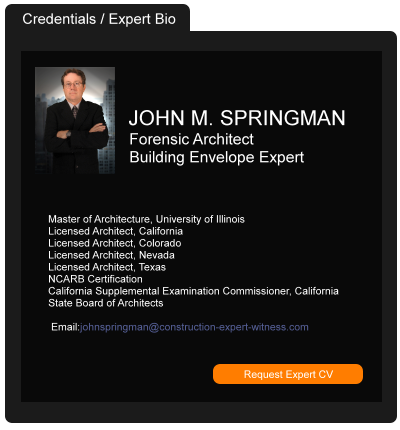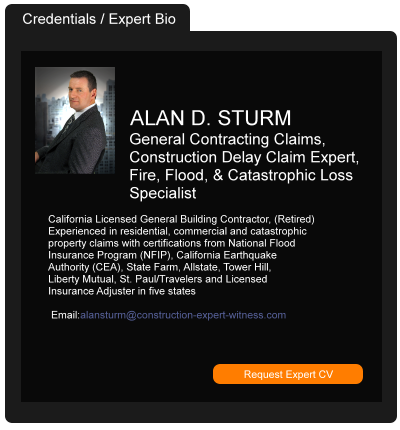Single-Family Home Gain Brightens U.S. Housing Outlook: Economy
January 21, 2015 —
Shobhana Chandra – BloombergBuilders broke ground in December on the most single-family homes in almost seven years, propelling an unexpectedly large gain in U.S. housing starts that signals construction will contribute more to economic growth in 2015.
Work began on 728,000 houses at an annual rate, a 7.2 percent increase from November and the most since March 2008, a Commerce Department report showed Wednesday in Washington. Total housing starts, which include apartments, climbed 4.4 percent to a 1.09 million pace.
Read the court decisionRead the full story...Reprinted courtesy of
Shobhana Chandra, BloombergMs. Chandra may be contacted at
schandra1@bloomberg.net
Risk Management and Contracting after Hurricane Irma: Suggestions to Avoid a Second Disaster
September 14, 2017 —
Stephen H. Reisman, Gary M. Stein & Adam P. Handfinger – Peckar & Abramson, P.C.Peckar & Abramson attorneys have assisted contractors in the immediate aftermath of several Hurricanes, including Andrew in 1992, Wilma in 2005, Ike in 2008, and Sandy in 2012. Based on this experience, we offer some post-storm strategies for contracting and risk management in three situations:
- Ongoing projects in the area directly impacted by the storm;
- Projects remote from the storm-impacted areas, but which may be affected by material or labor shortages; and
- Requests for assistance in recovery/clean-up/rebuild eff orts, which would be new projects.
Projects Directly Impacted By Hurricane Irma:
1. Immediately review each Owner contract to determine what notices are required for delays and/or extra costs arising from the storm. Contract notice requirements and time limits vary, whether for force majeure or other similar time and compensation rights. There is no effective one-size-fits-all solution. While the initial notice letters will likely look very similar, you should make sure that each is sent as required by the contract. Check each contract’s requirements for particulars regarding content, the form of delivery, and parties and individuals designated to receive the letters as well as carbon copy recipients like the architect. Follow-up notices and time periods differ from contract to contract and should be tracked so that if, for example, a follow-up notice is required in a week per the contract terms, it is tracked to ensure compliance.
Reprinted courtesy of Haight Brown & Bonesteel LLP attorneys
Stephen H. Reisman,
Gary M. Stein and
Adam P. Handfinger
Mr. Reisman may be contacted at sreisman@pecklaw.com
Mr. Stein may be contacted at gstein@pecklaw.com
Mr. Handfinger may be contacted at ahandfinger@pecklaw.com
Read the court decisionRead the full story...Reprinted courtesy of
Professional Liability Alert: California Appellate Courts In Conflict Regarding Statute of Limitations for Malicious Prosecution Suits Against Attorneys
April 28, 2014 —
David W. Evans & Stephen J. Squillario – Haight Brown & Bonesteel LLPIn conflict with an earlier decision by a different division within the same District, and with a prior decision of another District which followed the earlier case, Division Three of the Second Appellate District has concluded, contrary to established precedent, that the general two-year limitations period set forth in Code of Civil Procedure section 335.1 (“Section 335.1”) applies to malicious prosecution claims against attorneys, rather than the specific one-year statute of limitations for claims against attorneys codified in Code of Civil Procedure section 340.6 (“Section 340.6”).
In Roger Cleveland Golf Co., Inc. v. Krane & Smith, APC (filed April 15, 2014, Case No. B237424, consolidated with Case No. B239375), Roger Cleveland Golf Co., Inc. (“Cleveland Golf”), filed a malicious prosecution action against Krane & Smith (“the Attorneys”), who had unsuccessfully prosecuted the underlying breach of contract matter for their client against Cleveland Golf. In that action, on April 26, 2010, the trial court entered its order granting a motion for nonsuit and dismissing the complaint in favor of Cleveland Golf. On May 24, 2011, or approximately 13 months after the trial court had dismissed the underlying complaint, Cleveland Golf commenced a malicious prosecution action against the Attorneys. In the interim, the Attorneys initiated an appeal of the underlying judgment, which was eventually dismissed approximately seven months later. In response to the complaint, the Attorneys filed a special motion to strike, commonly referred to as an anti-SLAPP motion, which included the argument that the malicious prosecution claim was time-barred under the one-year limitations period of Section 340.6. The trial court granted the Attorneys’ motion based on the statute of limitations (and Cleveland Golf’s failure to demonstrate a probability of success on the merits) and dismissed the case. Cleveland Golf’s appeal followed.
Reprinted courtesy of
David W. Evans, Haight Brown & Bonesteel LLP and
Stephen J. Squillario, Haight Brown & Bonesteel LLP
Mr. Evans may be contacted at devans@hbblaw.com, Mr. Squillario may be contacted at ssquillario@hbblaw.com
Read the court decisionRead the full story...Reprinted courtesy of
ISO Proposes New Designated Premises Endorsement in Response to Hawaii Decision
October 27, 2016 —
Tred R. Eyerly – Insurance Law HawaiiThe Insurance Services Office (ISO) has issued a Circular advising it will submit to Insurance Departments in various states proposed changes to the Designated Premises Endorsement. The changes are due in part to the Hawaii Supreme Court's decision in C. Brewer & Co. v. Marine Indem. Ins., 135 Haw. 190, 347 P. 3d 163 (Haw. 2015). (Full Disclosure - our office represented C. Brewer before the Hawaii Supreme Court).
Read the court decisionRead the full story...Reprinted courtesy of
Tred R. Eyerly, Insurance Law HawaiiMr. Eyerly may be contacted at
te@hawaiilawyer.com
Texas Federal District Court Dismisses COVID-19 Claim
October 25, 2020 —
Tred R. Eyerly - Insurance Law HawaiiJudge Ezra, formerly on the bench in Hawaii, dismissed a COVID-19 claim pursued by a Texas policy holder. Diesel Barbershop, LLC v. State Farm Lloyds, 2020 U.S. Dist. LEXIS 147276 (W.D. Texas Aug. 13, 2020).
Local and state officials in Texas issued shutdown orders in March 2020 due to the spread of the cornavirus. All non-essential businesses, including the insureds' barbershop businesses, were ordered closed from April 2, 2020 until April 30, 2020. The insureds submitted a claim for business interruption and civil authority coverage to their carrier, State Farm. The claim was denied based on the policy's exclusion for loss caused by enforcement of ordinance or law, virus, and consequential losses. For Civil Authority coverage, State Farm contended the policy required that there by physical damage within one mile of the described property and that the damage be the result of a Covered Cause of Loss, which, State Farm asserted, a virus was not.
The insureds sued and State Farm moved to dismiss. The court noted cases in which courts had found physical loss even without tangible destruction to the covered property. Yet, the court found that the line of cases requiring tangible injury to property were more persuasive. Therefore, the court found that the insureds failed to plead a direct physical loss.
Read the court decisionRead the full story...Reprinted courtesy of
Tred R. Eyerly, Damon Key Leong Kupchak HastertMr. Eyerly may be contacted at
te@hawaiilawyer.com
New Hampshire Applies Crete/Sutton Doctrine to Bar Subrogation Against College Dormitory Residents
May 17, 2021 —
Kyle Rice - The Subrogation SpecialistPursuant to the Sutton Doctrine, first announced in Sutton v. Jondahl, 532 P.2d 478 (Okla. Ct. App. 1975), some jurisdictions consider a tenant a coinsured of its landlord absent an express agreement to the contrary. In Ro v. Factory Mut. Ins. Co., No. 2019-0620, 2021 N.H. LEXIS 34 (Mar. 10, 2021), the Supreme Court of New Hampshire held that the Sutton Doctrine, adopted by New Hampshire in Cambridge Mut. Fire Ins. Co. v. Crete, 846 A.2d 521 (N.H. 2004), extends to resident students in a college dormitory. Thus, absent specific language to the contrary, a student is an implied coinsured under the fire insurance policy issued for his or her dormitory.
In 2016, two students at Dartmouth College, Daniel Ro and Sebastian Lim, set up a charcoal grill on a platform outside of a fourth-floor window in the Morton Hall dormitory. The grill started a fire on the platform that ultimately spread to the roof of the dormitory. During fire suppression efforts, all four floors of the dormitory sustained significant water damage. Following the loss, the building’s insurer, Factory Mutual Insurance Company (Insurer), paid $4,544,313.55 to the Trustees of Dartmouth College for the damages.
Read the court decisionRead the full story...Reprinted courtesy of
Kyle Rice, White and WilliamsMr. Rice may be contacted at
ricek@whiteandwilliams.com
New York Instructs Property Carriers to Advise Insureds on Business Interruption Coverage
April 13, 2020 —
Tred R. Eyerly - Insurance Law HawaiiThe New York Department of Financial Services (DFS) took the unusual step last week of instructing all property/casualty insurers to provide information on commercial property insurance and details on business interruption coverage in light of the COVID-19 outbreak. The notice is
here.
The notice recognizes that policyholders have urgent questions about the business interruption coverage under their policies. Insurers must explain to policyholders the benefits under their policies and the protections provided in connection with COVID-19.
The explanation to policyholders is to include the following relevant information.
What type of commercial property insurance or otherwise related insurance policy does
the insured hold?
Does the insured's policy provide "business interruption" coverage? If so, provide the
"covered perils" under such policy. Please also indicate whether the policy contains a
requirement for "physical damage or loss" and explain whether contamination related
to a pandemic may constitute "physical damage or loss." Please describe what type of
damage or loss is sufficient for coverage under the policy.
Read the court decisionRead the full story...Reprinted courtesy of
Tred R. Eyerly, Damon Key Leong Kupchak HastertMr. Eyerly may be contacted at
te@hawaiilawyer.com
What Construction Firm Employers Should Do Right Now to Minimize Legal Risk of Discrimination and Harassment Lawsuits
October 07, 2024 —
Anthony LaPlaca, Dawn Solowey, Andrew Scroggins & Adrienne LeeSeyfarth Synopsis: In June 2024, Seyfarth published a blog article warning construction industry employers of recent anti-harassment guidelines issued by the EEOC. We predicted that the EEOC has “put the construction industry squarely in its sights.”[1] In this follow-up Alert, we discuss recent cases confirming the renewed regulatory focus on the construction sector, which demonstrate the need to put in place sound practices for non-discriminatory recruitment, hiring, and training of the work force in order to be prepared for this heightened risk of government scrutiny.
Recent EEOC Settlements
The U.S. Equal Employment Opportunity Commission (EEOC) has indicated, in no uncertain terms, that over the next five years it intends to prioritize the mitigation of systemic workplace problems and the historical underrepresentation of women and workers of color in the construction sector.[2] Two recent cases confirm that the EEOC is true to its word when it comes to tackling racial and gender disparities in the construction work force.
In August 2024, the EEOC secured two consent decrees with two separate construction firms in Florida, totaling nearly $3 million.
Reprinted courtesy of
Anthony LaPlaca, Seyfarth,
Dawn Solowey, Seyfarth,
Andrew Scroggins, Seyfarth and
Adrienne Lee, Seyfarth
Mr. LaPlaca may be contacted at alaplaca@seyfarth.com
Ms. Solowey may be contacted at dsolowey@seyfarth.com
Mr. Scroggins may be contacted at ascroggins@seyfarth.com
Ms. Lee may be contacted at aclee@seyfarth.com
Read the court decisionRead the full story...Reprinted courtesy of


































































